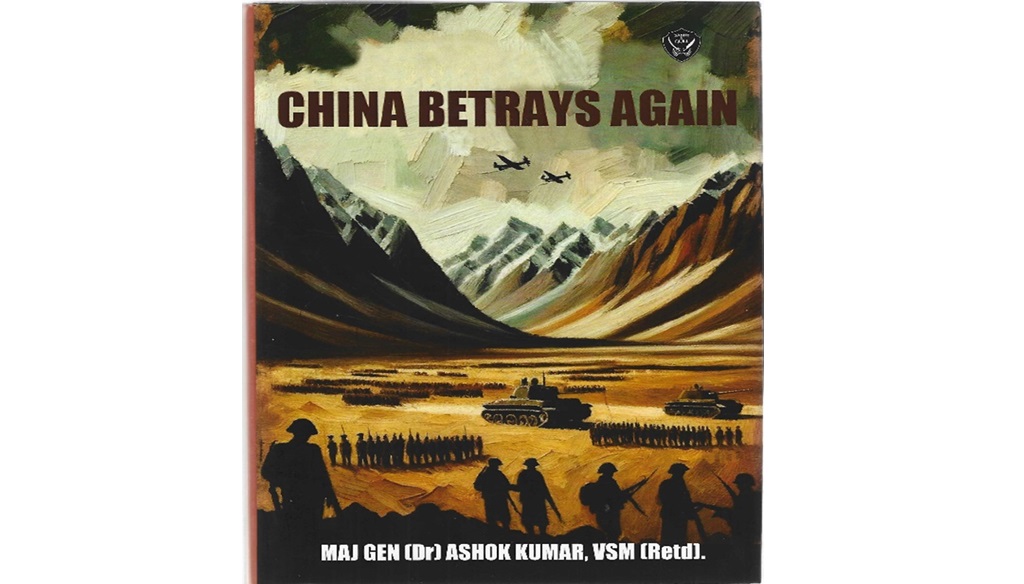BOOK REVIEW: CHINA BETRAYS AGAIN

By MAJ GEN JAGATBIR SINGH, VSM (RETD)
Pune, 13th February 2024: Maj Gen (Dr) Ashok Kumar is a prolific defence analyst who has been contributing regularly to various newspapers, magazines and journals including The First Post, Financial Express, Sunday Guardian, Salute, CENJOWS and CLAWS. Post retirement he has authored over two hundred articles on security related issues and his insights have contributed significantly to the ongoing discourse on contemporary geo-political affairs. An expert on China his book; “China Betrays Again” is a compilation of his articles in which with his clarity of thought he has broken down the complexities of issues to their fundamentals and provided the reader with a fresh and candid perspective on the subject.
The book sheds light on the recurring pattern of how China has been disregarding international norms and pledges while furthering its expansionist agenda and focuses on the events of May 2020 in Galwan, the effects of which have cast a dark shadow on the relationship between India and China. His views of course have been enriched due to his rich military experience and scholarship.
The unresolved border between India and China is the principal reason for conflict between the two nations. Ashok has gone into great detail writing about the border and its management. He writes that from the time India became independent till China occupied Tibet in 1951, there was a window of opportunity for India to sign a border agreement with the then Tibetan government provided that the Tibetan authorities agreed to the Indian viewpoint and its own need for a secure border’.
Having forcibly occupied Tibet, China began developing infrastructure and constructed the G219 connecting Hotan to Lhasa the alignment of which passed through the Indian side of the Johnson line, which was India’s claimed borderline while India was busy focusing on; “Hindi-Chini-bhai-bhai”. Post 1962 of course, no meeting ground could be reached even though China unilaterally withdrew from the areas they had captured but atmosphere had been vitiated. This was immediately followed by Pakistan handing over the Shaksgam Valley of Pakistan Occupied Kashmir to China and the close relationship that has developed between China and Pakistan also precluded any serious bilateral engagement.
Though the 1993 ‘Border Peace and Tranquility Agreement’ was a major step forward, ‘the alignment of the LAC did not have any effect on either of the country’s claims on the border’. It ‘also fell short on account of not factoring in military infrastructure, as well as not being clear on minimum force and mutual security’ which have now become reasons for confrontation between the two countries. China has been consistently undermining Indian positions and disregarding bilateral agreements.
As regards the large-scale transgressions which took place in April- May 2020 in Eastern Ladakh the author states that “ efforts were made at all levels political, diplomatic and military to advance the dialogue process but a resolution was farfetched ”. Though resolutions have taken place at some places but they have also resulted in creating buffer zones, a situation that did not exist prior to April 2020. It has been India’s stance that China must return to pre-war 2020 positions all along the LAC for normalizing bilateral relations.
The new land border law was introduced in the 31st Meeting of the Standing Committee of the 13th National Peoples Congress in October 2021. With 62 clauses in seven chapters the law provides a legal and coercive framework for China to assert itself using all elements of its Comprehensive National Power. The declaration of this law along with the rapid buildup of China’s military infrastructure will have serious implications for India and Bhutan.
Ostensibly meant to act as a framework for its border areas the law is most likely a fallout of the events in Eastern Ladakh. “The Chinese PLA and Chinese PAP, in accordance with their respective tasks will resist armed aggression, stop and prevent border crossings”. Armed action will be undertaken to evict intruders.
The law prohibits construction of permanent ‘facilities’ near China’s border without permission of Chinese authorities. The vague wording could be interpreted to include both sides of the border, creating potential for additional friction. Emphasising on the development of border towns and the role of civilians, the law raises questions on whether China intends to expand and accelerate civilian settlement in the region. With this law China has turned a boundary dispute into a sovereignty issue rendering it more intractable.
When a nation becomes independent, the first and foremost requirement is to delineate its borders and make arrangements to secure it which includes physical security. General Ashok states; ’that our manning of the Chinese border has been lacking since independence.’
Had India put in some effort to ensure a physical presence closer to the Kunlun Mountains, our claimed area post-independence, history may have been different. Yet this lesson has not been learned in all the areas. We manned the Sikkim border and the results at Nathu La and Cho La were different in 1967, in 1984 we occupied the Soltoro Ridge in spite of adverse climatic conditions. We ignored Eastern Ladakh and Arunachal Pradesh and have suffered there in 1987 as China occupied the Wangdung Camp South of Samdurong Chu.
Unfortunately, there are differing perceptions that exist at multiple areas. As against accepting a middle path for resolution both countries have been articulating as to why their stance is historically correct and the stance of the other incorrect.
The nosediving of trust from Galwan to Yangtse is a clear pointer that India needs to strengthen its security apparatus all along the LAC, the infrastructure push must be ensured to enable troops to be positioned at vulnerable locations, even if it involves substantial costs which can be reduced by modern surveillance means as there can be no compromise on national security.
While writing about the multiple Corps Commanders talks, the author clearly states that ‘conflict resolution is in the best interests of both nations.’ However, the continued stalemate in the talks and connected events are indicative of the possibility of escalation of conflict which requires constant monitoring and requisite preparedness.
It is clear that China wants to keep India engaged along the LAC. Galwan has resulted in mass mobilization of troops and an increase in troop deployments on a permanent basis which has not only a recurring cost but has also led to a recalibration of forces in other theatres and subsequent restructuring in order to deal with this emerging threat. Unfortunately, relations cannot return to normal unless a framework for settlement of the border issue is agreed upon by both countries.
What stands out in the book is authors analysis of the border dispute, which gives out the historical background from 1911 till the present, giving out how historical events have shaped China’s present strategy in dealing with its borders and this helps understanding its future perspectives and territorial expansionism.
The author clearly states that by ceding the Shaksgam Valley in 1963, getting operationalization of the Karakoram Highway, and being part of the Chinese BRI and CPEC, Pakistan has succeeded in getting China into the Indo- Pak Conflict. There are huge strategic, operational and economic commitments by China in PoK that ensure that it cannot take a back seat in any future conflict across the LoC in Gilgit – Baltistan.
There are many other important issues that have been delved into which include the Border Road Initiative, debt diplomacy in which Sri Lanka stands out as a case study, development of military infrastructure, China’s maritime expansion, its military technology and its Rocket Force.
The China challenge is ‘real’ and cannot be procrastinated any longer.
External support of any kind should be considered as a bonus and not as part of policy planning parameters. India has the potential to manufacture most of its defence requirements for which the private industry will need to step in.
In the contemporary international system, driven by great power rivalry and deep-seated conflicts and disarray, both India and China play a vital role in shaping and influencing global order. The book which contains more than fifty published articles casts a discerning eye on China and reveals the multi- faceted and often paradoxical relationship between the two countries.
There is no doubt that the book stands out as a valuable resource for those who are keen to understand the contours of the relationship between India and China. It is balanced, well written and provides a clear and concise overview on all key issues to include China’s economy, foreign policy, domestic politics and particularly the military perspective to understand the complexities and challenges posed by China’s rise. However though a bibliography would help readers to dwell deeper into the subject it remains a book which is indispensable while navigating China’s strategic landscape.








